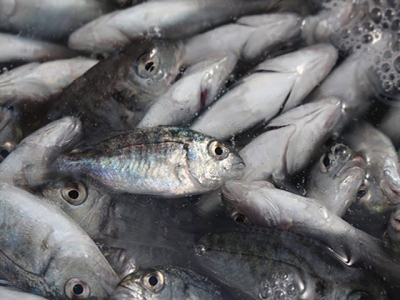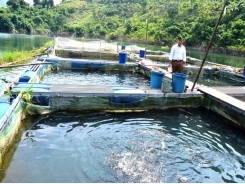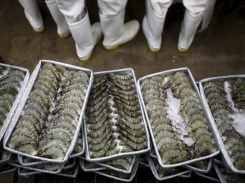Turning small fry into big business

One of the oldest marine finfish hatcheries in Europe has also become one of the most innovative, following a change of ownership in 2016.
Operated by Spanish marine fish farmers Tinamenor for four decades, the hatchery – which is situated in the northern Spanish region of Cantabria – was acquired by a group of investors in 2016. At the time it had the capacity to produce 20 million juvenile seabass and sea bream annually, as well as 110 million oyster and clam spat.
The company aims to produce 50 million seabass and sea bream fry a year
However, the new owners, led by Martín Alonso and Antonio Sainz, drew up a plan that aimed combine the experience of its 57-strong workforce with a fresh dynamism. The company was rechristened Sonríonansa – a nod to the River Nansa, on whose banks the hatchery is set – and a three-pronged strategy for the company to evolve was drawn up.
“The first part of the project has been to revamp the facilities and increase production capacity from the 15-20 million fry a year it had previously been producing – first up to 30 million, then to 50 million,” explains Carlos Mazorra, Sonríonansa’s R&D manager.
“We then decided to become entirely organic and since December 2017 we’ve been the only fully organic marine finfish hatchery in Europe. The third part of the strategy has been to develop new [consumer] products,” adds Carlos, who has been with the company for 14 years.
Consumer products might seem like a peculiar concept for a hatchery – given that market-sized bass and bream tend to weigh in around 500g, while Sonríonansa only grow fish up to 20g – but the new head honchos of Sonríonansa thought they had spotted a market for the 15 percent of the fish that failed to make the grade for ongrowing.
“We looked into making preserves from the slower-growing juvenile seabass and sea bream and formed an alliance with a two-Michelin-starred chef, Oscar Calleja, from the local village. After many trials, we’ve come up with six varieties of seabass and six of sea bream,” Carlos explains.
They’re currently very much targeting upmarket, gourmet food outlets but the company is now looking to tap in to the growing organic sector too.
“There are currently very few organic fish in the canned seafood category – while some wild-caught fish are canned with organic sauces, only farmed seafood can be certified as organic,” reflects Carlos, who believes it presents an opportunity for Sonríonansa to create a new niche.
The fry that they use in their range could not be used for ongrowing, so turning them into a premium product is a triumph – both of marketing and of sustainable food production.
“It’s a unique product, no one else is canning juvenile bass and bream,” Carlos says, “and the fact that we are able to open a new line of product with these fish is also a guarantee for our clients from the ongrowers’ market.”
“We operate in a very special location, a Natura 2000 network area [a region whose biodiversity is under the protection of the EU’s European Environment Agency]. We are involved in different actions, including a European LIFE [environmental funding] project, to promote a respectful relationship with the landscape, the fauna and the flora we live with, our environment. It simply makes sense that we look for ways to optimise the use of everything we produce from this relationship,” he adds.
As well as perfecting the recipes, Carlos explains that a canning protocol also needed to be established for the seabass and bream – which proved more of a struggle than expected, despite the depth of seafood canning experience available along the Spanish coast.
“Canning is an art, and we needed to draw on artisan experts as bass and bream are very different from most of the fish – tuna and anchovies – that are canned in this region. They’re not as oily, and it was a long process to perfect. But the end results have been very impressive – we’ve taken the products to the main culinary fairs in Spain and it’s been praised by the top chefs, and demand is growing,” he says.
Adding value is key
Carlos sees the canned juveniles as an example of how the seabass and sea bream sector – which has struggled to move beyond the sale of whole, fresh fish or fillets, can start to diversify its products and exploit new markets.
“I’m convinced that as a sector we have to work on marketing products, different presentations and adding value. As a company I’m sure we’ll launch other products in time too,” he says.
“We have to learn from the multiplication of products in the salmon sector. And in the Mediterranean seabass and sea bream might be joined by other species, like amberjack and meagre, soon too – these may be better suited to value-added products,” he adds.
As for the live fish that still make up 85 percent of their business, Sonríonansa distribute their stocks very widely, but have plans to focus on Europe’s western seaboard in particular.
“We currently sell juveniles to producers in Spain, Italy, Portugal, Madeira and even Völklingen, near Frankfurt, but would like to become the Atlantic hatchery for seabass and sea bream in Europe,” says Carlos.
And he hopes that they will also help to enable a sector-wide increase in organic production, both in the Med and on the Atlantic seaboard.
“A small proportion of the stocks produced by Cromaris and Kefalonia make up the entire organic bass and bream production in the Med at the moment. However, this is in part due to the lack of organic juvenile suppliers and speaking to companies at the BIOFACH exhibition in Nuremberg, there is a lot of excitement about more farmers turning to organic production,” Carlos says.
“We made the decision to go organic due to the lack of established independent organic hatcheries in the region and, as we increase our capacity we will allow other grow-out companies to consider organic production – there’s an increased interest in organic products in the EU retail sector and we expect that it will no longer be the exception, but become the norm,” he adds.
Even if the demand for organic bass and bream fry doesn’t materialise, Carlos believes that a shift to organic production techniques has improved the overall performance of the hatchery and the quality of the fish they produce.
“Since we began to farm to organic standards our performance has increased – we pay more attention to preventative fish-health strategies, animal welfare, feed quality and feed delivery, and it has resulted in much better survival, improved growth rates, fewer deformities and better FCRs. While organic production might be more expensive, the quality of the fish means that this increase in cost can be justified and we’ve had very good feedback from our customers about how the fish are performing in grow-out sites,” he explains.
At a time when Europe’s seabass and sea bream farmers have been struggling for inspiration, Sonríonansa’s attitude to both production and processing is a refreshing change. Whether they’re able to have a lasting impression on either the fish farming or foodie scenes remains to be seen but – either way – their ability to fetch a premium for bite-sized organic seabass should provide the marine finfish sector with plenty of food for thought.
Có thể bạn quan tâm
Phần mềm

Phối trộn thức ăn chăn nuôi

Pha dung dịch thủy canh

Định mức cho tôm ăn

Phối trộn phân bón NPK

Xác định tỷ lệ tôm sống

Chuyển đổi đơn vị phân bón

Xác định công suất sục khí

Chuyển đổi đơn vị tôm

Tính diện tích nhà kính

Tính thể tích ao hồ



 U.S. likely to approve Vietnamese tra fish compatibility:…
U.S. likely to approve Vietnamese tra fish compatibility:…  Rising dollar, market glut cut Vietnam’s shrimp export…
Rising dollar, market glut cut Vietnam’s shrimp export…